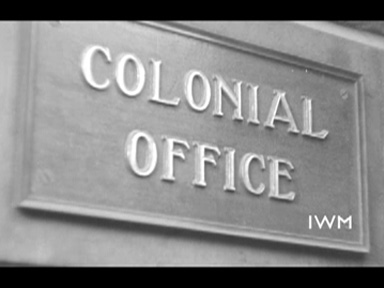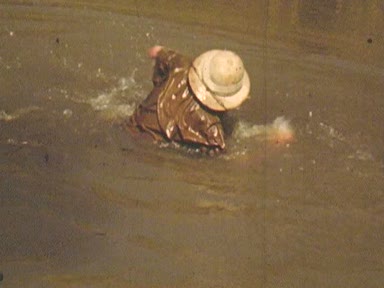Wildlife in Serengeti National Park. Sign posts in Park. Giraffes Leopards in trees. Vultures. Savanah countryside Visit to Park by British Pair in Land Rover with local guides. Views from small plane over the plains. Observation ...
Advanced Search
-
Selkirk Collection
-
Not Known
INTEREST. Travelogue. A railway journey in Northern Tanzania (?) and waterfalls on the River Pangani.
No main title. Filmed from the front of a moving train; train passes Africans (21). Back view of train as coal is loaded by Africans ...
-
Great Britain
INTEREST. The film shows a practical experiment to establish a new African settlement in tsetse-fly country.
The film opens with a local looking at a sign post 'To Kingolwira'. The African sets off in this direction and comes to a ...
-
TROPICAL HOOKWORM 1936

 Great Britain
Great BritainInstructional film for African audiences on the causes and prevention of hookworm disease.
An African man, 'a typical case of chronic hookworm', describes his symptoms to a friend. The film shows a close-up of the type of worms ...
-
Great Britain
The training of students at the Tanganyika Veterinary Department, Mpwapwa.
The film opens with a line of African men in uniform who have been selected for a course in which they will learn 'the future of animal husbandry'. A European ...
-
Buckland Collection
Scenes in the life of a civil engineer and his family in Tanganyika, including bush safaris and camps.
Production / Donor Details: These films were shot by L.L.R. Buckland, a civil engineer in the Tanganyika Public Works ...
-
Great Britain
A typical day at a Government Primary School in Tanganyika.
The film opens with a shot of a notice board stating "Government Primary School". The boys of the school are roused at 6.30 a.m. by a bugle. The boys get up, wash, sweep ...
-
Great Britain
A typical day of a Msukuma (Sukuma) man and his family in Tanganyika (now Tanzania).
The film introduces Kinga's home - huts in a clearing - before showing Kinga and his family, who are at work making bread, collecting wood and ...
-
Great Britain
A POGORO WOMAN AT IFAKARA AND OTHER POTTERS MAKING CLAY POTS, AND A POGORO MAN MAKING A BEER STRAINER BY SPLITTING AND WEAVING PALM LEAVES
-
MEN OF AFRICA 1940

 GB
GBDevelopment programmes in Kenya, Uganda and Tanganyika illustrate that "even in the midst of war, Great Britain does not shirk her responsibilities to her colonies."
An opening sequence of maps and stock shots ...
-
CARL PETERS 1941
Germany -
Cotterell Collection
Made in 1941, the film is a mixture of amateur actors recreating the early history of the goldfields (1920s) and documentary footage of the geography and wildlife of the area, with extensive sequences of a range of levels of gold ...
-
BRITISH ARMY OPERATIONS IN THE SECOND WORLD WARGB
Private Valentino Owori of the East African Pioneer Corps receives the British Empire Medal from Lieutenant General R.G.W.H. Stone, Commander of the British Forces in Egypt ...
-
Great Britain
Native life in Tanganyika and Kenya.
-
Great Britain
Ethnic scenes in Tanzania, including agricultural practices; tribal dancing of the Wa Matengo and Wa Nyasa.
-
SISAL 1945
Great BritainOn the cultivation and treatment of sisal in Tanganyika with an emphasis on the importance of the crop for war needs.
-
BRITISH ARMY OPERATIONS IN SOUTH EAST ASIA DURING THE SECOND WORLD WARGB
Lieutenant-General Sir Oliver Leese, commander Allied Land Forces South East Asia (ALFSEA), visits 11th East African Division.
At an airfield ...
-
BRITISH ARMY OPERATIONS IN SOUTH EAST ASIA DURING THE SECOND WORLD WARGB
Sixteen African chiefs, the heads of tribes represented in 11th East African Division fighting in Burma, are received at Government House in Colombo, ...
-
VICTORY PARADE 1946
 Great Britain
Great BritainColonial troops in England for the Victory Parade on 8 June 1946.
Colonial troops arrive in Britain for the Victory Parade. First, 'officers and men of the great West African Frontier Force' arrive at Liverpool on the liner ...
-
MEN OF TWO WORLDS 1946
 Great Britain
Great BritainAn African music student returns home and has to defeat the witch doctor who dominates his tribe and take them to healthier land. Solo pianist: Eileen Joyce.
Men of Two Worlds was released only in 1946, but had its ...
-
Great Britain
Various tribal dances of the Sukumaland people of Africa.
-
MARANGU 1948
Great BritainLife in the Chaga village of Marangu in Tanganika, near Mt. Kilimanjaro.
The film shows the role of the chief in stimulating economic and social progress and how European and African institutions operate side by side. It then shows ...
-
SISAL 1948
Great BritainThe cultivation of sisal on a plantation in Tanganyika; harvesting and processing the leaves; transporting the baled fibres for export; the fibres used in rope-making.
-
FIRST YEAR 1948
Great BritainThe Ground Nut Scheme in Africa by the United Africa Company.






